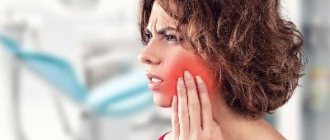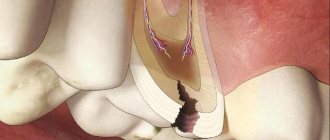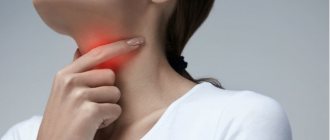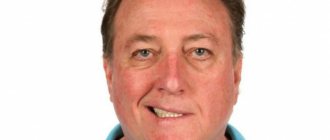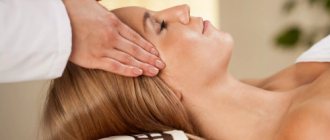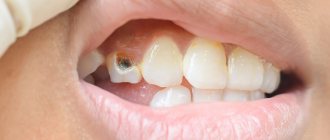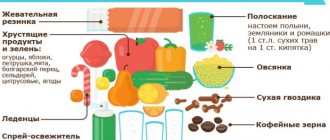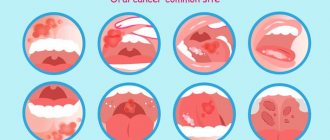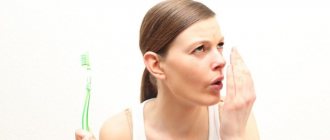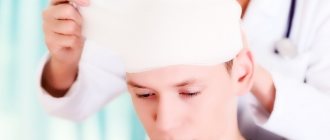Vegetative dystonia has many manifestations, for example, some patients experience numbness in the tongue due to VSD, a sore throat or disturbances in the processes of digestion and breathing. Many patients with numbness in the limbs, head or tongue use remedies to eliminate these symptoms, but they do not completely get rid of the problem.
Effective treatment of vegetative-vascular dystonia is based on eliminating the causes of the disorder. Thus, modern specialists have developed a set of methods to relieve nervous tension and reduce the production of adrenaline, which is one of the causes of unpleasant sensations. Neurologists, psychotherapists, cardiologists, and exercise therapy instructors provide high-quality treatment for VSD, which has various manifestations.
What is a stroke
The essence of a stroke is the cessation of blood supply and functioning of a part of the brain as a result of damage to a vessel.
The larger the affected area, the more severe the stroke. Necrosis of a portion of the brain substance is called an infarction [3]. There is a high risk of death in the first few hours, and then in the period up to 28 days after a vascular accident. The annual mortality rate from stroke in the Russian Federation is 374 cases per 100,000 [10]. In 2018, 35% of patients died in the acute period of stroke; by the end of the first year, this figure increases by 15%, and in general, in the first 5 years, the mortality rate of strokes is 44% [11]. The mortality rate from stroke was 92.9 per 100,000 population, and the hospital mortality rate was 19.1% [5].
Long-term disability is most likely for patients who have suffered a stroke. The prevalence of primary disability due to stroke in 2018 was 3.2 per 10 thousand population [2]. Of these, 31% need constant care, 20% have severe mobility limitations, and only 8% return to work [3]. The prevalence of recurrent strokes in 2014 was 0.79%, of which ischemic
strokes account for 87.5% [9].
Causes of stroke
Depending on the cause of cerebrovascular accident, ischemic and hemorrhagic strokes are distinguished.
Ischemic stroke occurs as a result of blockage of cerebral vessels by a blood clot, when gradually less and less blood flows to an area of the brain. Hemorrhagic stroke develops as a result of rupture of a vessel and hemorrhage in the brain tissue, as a result of which the blood supply to its area abruptly stops. Hemorrhage can be into the subarachnoid space (SAS) or directly into the cerebral substance (ICH). The ratio of ischemic and hemorrhagic strokes is 4-5:1 [4].
Pathologically, a stroke can be cardioembolic, lacunar, atherothrombotic, or another, including unknown, etiology (TOAST classification) [10].
Predisposing factors:
- men from 45 to 59 years old;
- age 70 years and older (for both sexes) [4];
- arterial hypertension;
- atrial fibrillation;
- atherosclerosis of cerebral vessels;
- coagulopathy, thrombophilia, anemia;
- arteriovenous malformations;
- osteochondrosis with damage to the vertebral artery;
- brain tumors;
- dyslipoproteinemia;
- obesity;
- diabetes;
- intermittent claudication;
- mechanical prostheses of heart valves and blood vessels;
- IHD, myocardial infarction less than 6 months before the stroke;
- other cardiac diseases;
- smoking, alcoholism;
- family history of stroke;
- sedentary lifestyle;
- stress [1, 3].
Suprastin: side effects and symptoms of overdose, dosage for children and adults
The number of allergic diseases in the world is growing every year. Accordingly, the demand for drugs that help effectively combat them is growing. Allergies are widespread due to various reasons - unhealthy diet, environmental pollution, stress and much more.
Suprastin is a drug belonging to the category of chloropyramines; it is a chlorinated analogue of pyribenzamine. This is a first generation antihistamine, belongs to the group of ethylenediamines .
Studies have shown that Suprastin helps well with various allergic pathologies in adults and children, including hay fever. Like other medications, Suprastin has its contraindications and side effects.
Characteristics of antihistamines
This drug belongs to the category of antihistamines. Histamines are biologically active substances that provoke allergies. Histamine causes the following symptoms:
- itching;
- swelling of tissues;
- secretion;
- blood vessels dilate sharply.
Antihistamines cannot reduce the amount of histamine, but they help block tissue receptors that are sensitive to this substance.
Suprastin, like other antihistamines, help eliminate or reduce the following effects of histamines:
- increased tone of smooth muscles in the bronchi;
- increased muscle tone of the uterus and intestines;
- decreased blood pressure;
- capillary permeability increases, which provokes the appearance of edema;
- itching and redness of the skin and mucous membranes.
Suprastin, along with diphenhydramine, also tends to depress the nervous system. Accordingly, it additionally has a hypnotic and calming effect.
Antihistamines are used to treat allergic conditions, they are especially effective for skin lesions and lesions of the mucous membranes, for example:
- Quincke's edema;
- hives;
- conjunctivitis;
- allergic rhinitis.
But if the patient suffers from severe allergic diseases, for example, anaphylactic shock, then such drugs will not be effective.
Characteristics of Suprastin
The antihistamine drug Suprastin also has the non-patented international name chloropyramine. It is available in the form of tablets and injection solutions; the drug suppresses the functioning of histamine receptors , which reduces capillary permeability. The drug has a calming effect, relieves itching and partially relieves bronchospasm.
After taking a tablet or injection, Suprastin is absorbed into the blood, then it is distributed to organs, including the central nervous system. The drug is broken down in the liver, then exits through the kidneys along with the urine. Moreover, in children the drug can be eliminated faster than in adults.
Instructions for use of Suprastin
The use of this drug depends on the form of its release. So, if we are talking about tablets, then they need to be taken with food, cannot be chewed, but they should be washed down with plenty of liquid.
The recommended dosage for an adult is up to 4 tablets per day , for children from 1 month to a year - 2 tablets up to 3 times a day, they are ground well and added to baby food.
From one year to 6 years, children are prescribed 2 pieces or half three times a day. From 6 to 14 years old you need to give 0.5 tablets 2-3 times a day. The dosage is increased if the disease is advanced or if there is no effect.
An overdose should not be allowed; the maximum dose is 2 mg of Suprastin per kilogram of weight.
But Suprastin in the form of an injection solution is administered intramuscularly or intravenously in difficult cases and under strict medical supervision.
The recommended dosage for adults is up to 2 ampoules per day . Suprastin in ampoules is prescribed to children in the following quantities per day:
- 1 month – up to a year – 0.25 ml;
- 1 year – 6 years – 0.5 ml;
- 6 – 14 years – 1 ampoule.
Indications for use of Suprastin
Indications for the use of Suprastin in children and adults are as follows:
- allergic diseases - rash, hives, runny nose and conjunctivitis;
- immediate allergic reactions – angioedema and anaphylactic shock;
- prevention and treatment of allergic manifestations after taking certain medications, as well as insect bites.
Contraindications
To prevent side effects and overdose, Suprastin is contraindicated in the following cases:
- if there is an individual intolerance to this drug;
- with prostate adenoma, when the passage of urine is disrupted;
- for glaucoma;
- children up to one month old;
- during pregnancy;
- when breastfeeding;
- premature babies older than one month;
- while taking MAO inhibitors;
- in acute myocardial infarction or arrhythmia.
Doctors prescribe Suprastin with extreme caution to older people, as well as to patients with liver and heart diseases, exacerbations of erosive and ulcerative diseases of the gastrointestinal tract and urinary retention. While taking the drug, you should not operate machinery or drive vehicles.
Suprastin: side effects
This drug may cause the following side effects:
- from the central nervous system, lethargy, fatigue, problems with coordination of movements, headache, irritation, tremors of the limbs, convulsions, blurred vision and euphoria may be observed;
- effects on the gastrointestinal tract - nausea and dry mouth;
- Other side effects include decreased blood pressure, problems with urination, increased heart rate and heart rhythm disturbances, allergies to sunlight, and increased intraocular pressure. In rare cases, decreased immunity and anemia have been observed.
Suprastin should be taken with extreme caution simultaneously with painkillers and sedatives, as well as antidepressants, since the effects of taking them can be greatly enhanced.
Suprastin: overdose
An overdose of Suprastin manifests itself in the following syndromes:
- The central nervous system is depressed or excited;
- the appearance of hallucinations;
- coordination of movements is impaired;
- pupils dilate;
- convulsions;
- dry mouth;
- increased body temperature;
- loss of consciousness and coma are extremely rare.
To get rid of overdose syndromes and subsequent problems, it is recommended to rinse the patient’s stomach and take about 20 tablets of activated carbon . If the patient's condition does not improve after this, you should immediately call a doctor.
To prevent the occurrence of side effects, as well as overdose, the course of treatment with Suprastin should be prescribed only by a doctor. The specialist chooses the duration independently, depending on the characteristics of the disease and its complexity.
Features of the use of Suprastin for children and pregnant women
Suprastin should not be used to treat premature babies and newborns. It can be given to babies from one month old and to adults. If the child’s allergic reaction is weak, then the drug can be given a maximum of once a day. And in case of a complex form of the disease, Suprastin is prescribed up to 3 times a day.
Sometimes children experience an atypical reaction to the drug , which is expressed by such effects as:
- insomnia;
- anxiety;
- overexcitement.
The duration of treatment of a child with Suprastin is up to a week. If during this period the signs of the disease do not disappear, you should consult a doctor.
If we talk about the use of the drug during pregnancy , then studies on this issue have not yet been carried out in sufficient quantities to say for sure whether this drug harms the fetus or not. Therefore, the decision to use this medicine during this period can only be made by a doctor. But during breastfeeding you will need to stop taking the drug.
Features of using Suprastin
You should know that each tablet of the medicine includes a small amount of lactose monohydrate, but even this is enough for a patient suffering from lactose deficiency to experience side effects. And when used simultaneously with ototoxic drugs, the drug can relieve early manifestations of ototoxicity.
If the patient suffers from liver or kidney diseases, then the dosage will need to be reduced , so you need to warn the doctor in advance about your ailments. At night, while taking Suprastin, the symptoms of reflux-esophigitis may intensify.
At the beginning of treatment, the drug may cause dizziness, drowsiness and severe fatigue. It is not recommended to drive at this time.
Now that we have examined the main features of taking Suprastin, its possible side effects and described what is accompanied by an overdose, it will be easier for you to use it, in addition, you will not forget to warn your doctor about the presence of concomitant diseases.
Source: https://allergo.guru/preparaty/suprastin-primenenie-pobochnye-effekty-i-peredozirovka.html
Signs of an incipient stroke
The onset of a hemorrhagic stroke is characterized by the following symptoms:
- severe headache;
- increased blood pressure;
- vomit;
- dizziness;
- loss of consciousness;
- weakness in the limbs;
- visual impairment;
- seizures [1].
The onset of ischemic stroke is gradual; within an hour, some of the following symptoms appear:
- facial asymmetry, numbness;
- difficulty speaking – incoherent, impaired understanding;
- double vision, visual disturbances;
- headache;
- numbness, limited mobility in the limbs, often on one side;
- dizziness, imbalance, staggering, staggering gait;
- confusion with disorientation, subsequently there may be loss of consciousness [3].
If one or more of these signs appear, you should:
- Sit the patient down, providing access to fresh air.
- Call emergency medical help immediately.
- If the patient is conscious and able to chew and swallow, give him one aspirin tablet.
The patient must be hospitalized in a neurological or neurosurgical department, where stroke treatment will be carried out. The sooner the patient is in the hospital, the more effective the therapy.
Other Adverse Effects
Self-medication with Corvalol can mask the symptoms of more serious diseases, such as cancer. The components of the drug cannot be called beneficial to health. In addition, the drug may have a pronounced placebo effect. On the one hand, this is good and increases its effectiveness. On the other hand, patients stop taking medications that are really necessary for diseases of the cardiovascular system. Patient adherence to treatment is a big problem in cardiology.
Yes, perhaps they act more slowly and do not bring relief immediately, but it is their use that increases life expectancy and reduces the risk of heart attacks and strokes (statins, antihypertensive drugs, antiplatelet agents). Because they act on the mechanisms of disease development, and do not simply mask the symptoms.
Corvalol drops at night can become for an elderly person an imaginary concern for their health and a ritual of self-soothing. Then, if symptoms intensify or new ones appear, he does not go for examination, but simply increases the dose. This is especially true for residents of areas with low access to medical care.
Symptoms of a stroke
Stroke leads to various brain injuries, depending on the location of the lesion and the pathological type of cerebrovascular accident:
- disturbances of movement in the limbs: from restrictions (paresis) to complete paralysis. When the lesion is localized on the right, the left limbs suffer; with a left-sided lesion, right hemiparesis is formed; in some cases, movements in all limbs may stop (tetraparesis or double hemiparesis);
- sensory disturbances on one or both sides;
- speech disorders (dysarthria - poor articulation; aphasia - inability to pronounce and understand words, write and read);
- ataxia (impaired coordination of movements, “overshooting”, unsteadiness, imbalance, tremor);
- visual impairment: from blindness to double vision and gaze paresis;
- hearing impairment and dizziness;
- violation of mental functions (consciousness, thinking, attention, memory, will, behavior);
- paresis of the soft palate and pharynx, swallowing disorders;
- disorders of urination and defecation;
- depression of respiration and vascular tone;
- increased intracranial pressure;
- patients complain of headaches, vomiting, hiccups, yawning, shoulder pain;
- consciousness is gradually depressed to the point of coma [1, 3].
Causes of death may include cerebral edema, pneumonia, heart failure, and recurrent stroke. In severe cases, “locked-in syndrome” may develop: the patient is conscious, but cannot move, swallow or speak [3].
Features of the course of neurosis in women
Neurosis is diagnosed in a third of the world's urban population. Neurology is one of the most common ailments of the nervous system—the disease occurs in every fourth person with mental illness. A study of the incidence of neurosis has shown that neurotic disorders are common in men and women over 30 years of age. However, neurotic disorders in women usually occur in a more severe form than in men.
The reason for such conclusions is the emotionality of women. Doctors note that neurosis most often appears in expressive and emotional people. According to statistics, women are more sensitive than men.
Experts also say that, unlike men, women suffer from neurosis almost twice as much. Menopause is considered one of the causes of neurosis in women. Any hormonal changes affect our nervous system and can bring unpleasant consequences.
Perhaps, in this case, a social factor also plays a role - men are less likely to go to doctors, especially to a psychotherapist. However, today experts say that the flow of men to psychotherapists has increased, but women are still more willing to go to a doctor for help.
Also, by the will of fate and centuries-old traditions, not only a career and daily work falls on a woman’s shoulders, but also cleaning the house and raising children. The modern woman has more tasks, the principle “you need to be strong and hold on” is firmly stuck in your head. However, this unknown force will not protect you from overload and fatigue. Then for help you need to contact a psychotherapist who will prescribe treatment. Psychotherapy sessions help to influence the cause of neurosis, change the attitude towards a traumatic situation and facilitate the release of emotions, accelerating recovery.
Symptoms of neurosis in women
The signs of neurosis in women differ from the opposite sex due to our physiological characteristics of the body. For example, among women the list of symptoms of neurosis includes insomnia, frequent nightmares and sleep paralysis, but this is not observed in men. Also, in women with neurosis, there is a deviation in the menstrual cycle.
Doctors identify the following most common symptoms of neurosis in women:
- anxiety;
- irritability;
- expressiveness of behavior;
- refusal to eat;
- impairment of physical qualities: loss of strength, feeling tired, loss of endurance;
- heart and headaches;
- vestibular disorders, balance disorders
- excessive tearfulness;
- sudden mood swings.
There are several types of neurosis, one of them is hysterical, most often called hysteria. According to doctors, signs of this type of disease are most often observed in women. Experts interpret hysterical disorder as an ardent desire to attract attention to the sick person. The disease is characterized by demonstrative behavior. A person suffering from such a disease often screams loudly, makes scandals, and sobs bitterly.
Medical psychotherapists have extensive experience and all the necessary resources for the successful treatment of neuroses.
Features of the course of neurosis in children
Neurasthenia is also common in children of primary and preschool age. Symptoms of the disorder are similar to those in adults. The difficulty in determining pathology lies only in the fact that young children often cannot explain what is happening to them and how they feel.
The child's appetite decreases, sleep problems appear, and nightmares often occur, as a result of which the baby may even cry out in his sleep and wake up without understanding what is happening. Increased sweating occurs and the temperature of the extremities decreases.
In addition to all the above signs of pathology, the child may have a headache, he is sensitive to bright light and loud sounds. There is also often a sharp change from positive emotions to negative ones: crying, aggression and depression.
Experts recommend immediately seeking help from a doctor, since neurosis in childhood is much more difficult to treat than in adults.
What types of neurosis exist and how do they differ?
- Depressive.
This type of neurosis is characterized by such symptoms in a person as tearfulness, sudden changes in mood, feelings of despair and helplessness. The person suffering from the disorder loses interest in life and becomes melancholy. During depressive neurosis, a person experiences low self-esteem, guilt, and frustration. - Anxious.
Often has manifestations at the physical level: dry mouth, increased sweating, rapid heartbeat. Anxiety neurosis can result in panic attacks and phobias. A person constantly experiences a feeling of fear. - Hysterical (“conversion disorder”)
- most often manifests itself if a person has experienced a strong emotional shock or a traumatic event. There is a change or loss of motor/sensory function indicating a physical disorder that is not detected. For example, after an accident, a person may experience loss of speech, although there is no physical reason for this. - Obsessive-compulsive.
Intrusive thoughts and images appear. Often such thoughts have no rational grain and are catastrophic in nature. To counter the overwhelming anxiety, a person performs compulsive, repetitive actions. - Rehearsal.
It manifests itself as attempts to resolve an issue that in the past remained unfinished. A person suffering from rehearsal neurosis transfers conflicting relationships from the past to the present and believes that this reality still exists today. - Hypochondriacal.
The patient becomes too suspicious and overly concerned about his health; he finds symptoms of various diseases where they actually do not exist. A person invents a terrible disease, torments himself, and stress or anxiety appears. Despite negative tests and consultations with doctors, the patient remains convinced of this. - Depersonalization.
Fear, panic and anxiety appear. It’s as if a person lives in a dream, “disconnecting” from his own body and thoughts. - Military or post-traumatic stress disorder.
It manifests itself under very shocking circumstances, when a person saw death or was captured or suffered serious injuries (physical and psychological). This type of neurasthenia is manifested by very strong stress, panic attacks, and an aggressive state. Such stress is dangerous because it can lead to disability, including functional disability that negatively affects daily life.
For example, a person believes that everyone treats him badly or no one likes him. As a result, he begins to behave in accordance with his ideas about others.
Neurosis and memory problems
Excessive anxiety leads to decreased concentration, which means that the patient often has problems with memory and attention. In order to influence the problem, you can take vitamin complexes of natural origin, as well as conduct useful memory training.
Experts recommend engaging in light physical activity and daily exercise to relieve anxiety and excessive worry.
Try not to multitask, this will only make the problem worse. It is better to remove all distractions while working or doing what you love. Such distractions include a mobile phone or any other mobile device. Turn them off when doing important things.
To reduce the strain on your eyes and brain, take breaks from work and study. Don't overwork yourself. You can take a walk in the fresh air or do some exercise.
Neurosis and psychosis: what is the difference?
Often these concepts are confused or interchanged. But diseases are different in their manifestations and the internal feeling of a person. For example, during the development of obsessive-compulsive neurosis, a person maintains a sense of reality and looks for new ways to adapt to it. He recognizes that he is suffering from a disorder and that this suffering is a product of mental instability.
During psychosis, a person perceives the world around him differently. He adapts reality according to his personal perception (often delusional), experiences hallucinations and delusions. And the main thing is how psychosis differs from neurosis: the patient is not aware of his problem.
Neurosis and vegetative-vascular dystonia
As we mentioned above, during neurosis signs appear on the physical level, such as rapid heartbeat, fluctuations in blood pressure, chest pain, difficulty breathing, etc. All these symptoms are similar to the signs of a disease such as vegetative-vascular dystonia.
VSD is a complex of symptoms of different localization that occur when there is a malfunction in the autonomic nervous system. And neurosis is a disorder of the central nervous system caused by the psyche (stress, depression, etc.). Since the nervous system is connected, disturbances in one department provoke disruptions in the functioning of another.
How is neurasthenia diagnosed?
To diagnose and identify the disease, you need to consult a neurologist, and sometimes a psychologist and psychiatrist. At the city clinic, you can contact your primary care physician, who will write a referral to a neurologist. However, this takes time. You often have to wait 2 weeks for an appointment with a doctor. In some cases, this is simply impossible, since it is necessary to quickly conduct an examination and prescribe treatment before the situation becomes critical.
Therefore, we recommend contacting the Medunion medical clinic. We employ practicing neurologists, and you don’t have to wait several weeks for appointments. Sign up today for a time convenient for you, not for the remaining time, and get tested tomorrow.
Patients choose us because we provide the service of a specialist coming to your home if you cannot come to the clinic on your own. You can also take samples directly at home.
Diagnosis includes interviewing the patient or his immediate family (guardians), collecting anamnesis and studying the medical history. To make a diagnosis, the doctor needs to know the symptoms that bother the patient.
To exclude other pathologies, the neurologist prescribes laboratory tests:
- Blood analysis;
- Analysis of urine;
- Ultrasonography;
- CT scan;
- Magnetic resonance imaging.
The specialist will also conduct psychological tests. For example, color technique. It consists in the fact that the patient is offered a palette of colors from which he must choose the color he likes. Colors such as purple, gray, red, brown, black indicate a high probability of developing neurosis.
Consequences of a stroke
There are transient ischemic attack (less than a day), minor stroke (from 1 day to 3 weeks) and stroke with persistent residual effects. The consequences of a stroke are expressed mainly in motor and sensory disorders, the formation of muscle contractures (pronounced constant restriction of movements in the joints), speech and swallowing disorders. General symptoms may also remain, including confusion, disturbances in thinking, will, and emotional regulation. Complications can develop: from epilepsy to bedsores, encephalopathy and anxiety-depressive syndrome [1, 3].
Bottom line
Paresthesia of the tongue and dizziness do not always signal the presence of pathology. Anxiety symptoms can be caused by stress, medications, or anesthesia. Poor circulation and curvature of the spine are accompanied by similar symptoms. However, it is not recommended to independently find out the cause of discomfort and try to eliminate it. Such symptoms are possible in a number of serious illnesses, the presence of which a person may not even suspect. Therefore, it is better to play it safe and start treatment of the disease on time, if any.
Diagnosis of strokes
First of all, it is necessary to conduct a detailed neurological examination. Instrumental diagnostic studies and laboratory tests are also prescribed. In case of a stroke, in the first hours, an MRI or CT scan of the brain is performed, if necessary, CT or MR angiography, color Doppler mapping of blood flow, ECG or Holter monitoring, echocardiography as indicated, monitoring of blood pressure, saturation, assessment of the risk of developing bedsores, assessment of swallowing function [ 1, 3, 6].
Tests for stroke
- Complete clinical blood test, including erythrocyte sedimentation rate (ESR).
- Biochemical blood test with determination of C-reactive protein and homocysteine, glucose level, platelet count, activated partial thromboplastin time, INR.
- Interleukin 10.
- Extended coagulogram.
- Determination of acid-base status.
- General urine analysis.
To prepare for neurosurgical intervention, a blood test is additionally performed for hepatitis, syphilis, HIV, blood group and Rh factor determination.
Compound
The effects of taking Corvalol are easily explained by its composition.
Alpha-bromoisovaleric acid ethyl ester has a sedative effect similar to valerian. It helps relax the smooth muscles of internal organs, slows down the transmission of nerve impulses and reduces blood pressure.
Phenobarbital in small dosages causes drowsiness, relaxation, and also relaxes smooth muscles. Increases the resistance of the nervous system to irritants, promotes the onset of sleep, but the sleep that occurs is not physiological.
Peppermint leaf oil promotes dilatation of blood vessels in the heart and brain. Strengthens intestinal contractility.
The combination of these components enhances their effect.
Stroke treatment
Treatment of stroke is regulated by relevant clinical guidelines and the Procedure for providing medical care to patients with acute cerebrovascular accident. In the first hours, thrombolytic therapy is carried out and subsequently - prevention of thrombus formation. For hemorrhagic stroke, neurosurgery may be performed. They normalize blood pressure, water-electrolyte balance, glucose levels in peripheral blood and urine, support the basic vital functions of the body and prevent complications. Drug therapy is also aimed at improving the affected functions of the nervous system [1, 3, 6].
Learned the language: COVID can cause lesions in the oral cavity
Dentists warn: coronavirus can cause a number of inflammatory processes in the oral cavity of patients. In particular, doctors from Brazil described the occurrence of ulcers and plaques, as well as cracks on the tongue of an elderly patient hospitalized with COVID-19.
In addition, those infected may develop a taste disorder, fungus, candidiasis and other pathological conditions in the mouth.
Russian experts believe that such symptoms can be observed as secondary manifestations of infection, as well as side effects from taking medications, in particular antibiotics.
Moreover, dental problems themselves can serve as a risk factor for infection, as they weaken the body’s protective functions. Therefore, it is advisable to include a dental examination in the list of necessary tests for COVID-19.
Secondary lesion
Scientists from the Laboratory of Oral Histopathology at the Faculty of Health of the University of Brazil described in their article lesions of the oral mucosa in a patient with coronavirus infection.
An elderly man admitted to the hospital with COVID-19, in addition to loss of taste, developed yellow ulcers in the mouth similar to herpetic ones on the 24th day of hospitalization, as well as deep fissures and a specific white plaque on the back of the tongue. Dentists were called to assess these injuries to the man.
Doctors concluded that these were secondary lesions resulting from systemic deterioration of health due to COVID-19.
Scientists also reported that oral signs and symptoms of coronavirus may include dysgeusia (taste disorder - Izvestia), petechiae (point hemorrhages in the form of red bumps), candidiasis, traumatic ulcers and other various lesions of the tongue and mucous membranes. Therefore, it is advisable to include a dental examination in the list of necessary tests for COVID-19.
“The relevance of the dentist as part of an interdisciplinary team to support critically ill patients in intensive care units should be emphasized,” the article states. In addition, it is necessary to provide dental follow-up after the patient is discharged from the hospital.
Hiding in the mouth
Despite the fact that dental symptoms specific to COVID-19 have not yet been discovered, often those infected develop conditions caused by the general effect of the infection on the body. For example, many patients complain of dry mouth.
As Izvestia was told by the head of the department of therapeutic dentistry at the First Moscow State Medical University. THEM. Sechenova Irina Makeeva, this often happens to people suffering from diabetes.
Also, this symptom may be a side effect of medications that are used to treat coronavirus: diuretics, blood pressure lowerers, antiallergic drugs.
— Sustained lymphadenitis (enlarged lymph nodes. — Izvestia) may occur for no apparent reason.
Scientists also reported that patients with COVID-19 may develop ulcers on the body and mucous membrane of the mouth that have never existed before, the specialist explained.
— A very common symptom is the loss of taste sensitivity. Patients characterize eating as “chewing soap, cotton wool.”
A situation where coronavirus becomes the cause of oral diseases is quite possible, Maret Khashieva, general director of the German Dental Implantology Center, told Izvestia. Against the background of this infection, diseases such as herpes and stomatitis may appear.
- This is due to decreased immunity. Oral diseases can also be caused by medications prescribed to treat coronavirus infection. These primarily include antibiotics. Taking them, especially long-term, disrupts the balance of microflora, which can cause the development of candidiasis (thrush) in the oral cavity, the expert emphasized.
Moreover, people with dental problems are at risk for contracting coronavirus.
Among the diseases that increase the risk of infection are various types of stomatitis, gingivitis and periodontitis, noted Maret Khashieva.
As for caries, in itself it is not a “gateway” for infection, but the immune system will in any case be “distracted” by such lesions. And this significantly weakens the body’s defenses.
The Ubiquitous Enzyme
The reason why coronavirus can damage the mucous membranes of the mouth and tongue is not only due to a general decline in immunity and drug therapy.
According to Irina Makeeva, SARS-CoV-2 is able to bind to the ACE-2 molecule (angiotensin-converting enzyme 2 - a membrane protein, the entry gate for the virus into cells.
- “Izvestia”) and express (multiply) on epithelial cells of the oral mucosa.
“In the latest published data, it was found that oral cavity cells have high expression of ACE-2, comparable to lung tissue cells,” the expert explained.
Thus, most oral tissues contain target cells for the Wuhan pathogen.
However, for now it is impossible to draw a clear parallel between the manifestations of dental diseases and the severity of coronavirus infection, since too little statistical data and clinical observations are available, Marina Kolesnichenko, the chief physician of a private dental clinic, told Izvestia.
— Such patients are not under the supervision of a dentist, because the infectious disease must first be treated. The only exceptions are cases that require immediate dental care,” the expert emphasized.
As for conducting dental examinations in intensive care units, there are a number of difficulties, experts noted. A large number of viral agents are found in saliva and blood. In this case, there is a high probability of infection of medical personnel. Therefore, such events are not held now.
However, as reported by Sechenov University, a dental examination may be recommended for patients in intensive care units.
With due observance of safety measures to correct the general hygienic status of the subject and reduce the negative impact of inflammatory diseases on the course of the infection.
Source: https://iz.ru/1031981/mariia-nediuk/izuchili-iazyk-covid-sposoben-vyzyvat-porazheniia-polosti-rta
Stroke rehabilitation
Stroke is a disease in which rehabilitation and care are of the utmost importance.
Recovery from a stroke begins in intensive care, from the moment vital functions are stabilized. A multidisciplinary rehabilitation team works with the patient, which includes a rehabilitation doctor, physical therapist or exercise therapy instructor, speech therapist, massage nurse, physiotherapist and physical therapy nurse, psychologist, occupational therapist, guard and rehabilitation nurse. Diagnosis is carried out using special scales that reflect the degree of dysfunction and limitations in the patient’s activity, the influence of environmental factors on the rehabilitation potential. The rehabilitation process continues throughout the entire period of hospitalization. At the second stage, patients with serious disabilities who are unable to move independently are sent to rehabilitation departments or specialized hospitals. Those who can walk independently or with support are rehabilitated in outpatient centers based in clinics and sanatoriums.
The rehabilitation process should not be interrupted, so classes must be continued at home. Of course, there are no high-tech robotic complexes or physiotherapeutic equipment at home, but exercise therapy, massage, and work with a psychologist, speech therapist and occupational therapist are possible. For this purpose, telemedicine technologies are used and visits to rehabilitation specialists are organized.
The individual rehabilitation program includes not only a referral for rehabilitation treatment, but also technical means of rehabilitation. However, usually relatives also have to devote significant physical and financial resources to achieve the best effect [7].
Advantages of treatment at the Yusupov Hospital
The Yusupov Multidisciplinary Hospital is a modern medical institution that maintains the tradition of attentive treatment and respect for each patient, which is especially important in the treatment of vegetative-vascular dystonia.
During consultations with patients complaining of a lump in the throat due to VSD, specialists from the Yusupov Hospital clearly explain how to get rid of the unpleasant sensations. When treating patients, only proven methods are used, so the services provided meet international standards.
The therapy program, compiled by highly qualified specialists at the Yusupov Hospital, allows patients to be relieved of the main disorder and its manifestations, such as dry throat during VSD, increased anxiety, profuse sweating, numbness of the tongue, disruption of the gastrointestinal tract, and panic attacks.
If you experience discomfort in the throat, numbness of the tongue or other unpleasant symptoms, contact the clinic to determine the cause. Pre-registration for a consultation with specialists allows patients to choose the most convenient time and avoid queues. Make an appointment with specialists at the Yusupov Hospital.
Prevention of strokes
Hereditary predisposition to stroke, the presence of cardiac diseases, pathology of blood vessels and blood composition, age over 40 years, obesity and diabetes require a number of preventive measures:
- Maintaining normal blood pressure, taking antihypertensive drugs as prescribed by a doctor, monitoring blood pressure.
- Maintaining a normal level of physical activity, exercise, walking 30-40 minutes a day (for example, walking the dog).
- Conducting preventive examinations, including a standard set of laboratory parameters. During a preventive examination, the following tests are additionally required: gene diagnosis of CADASIL syndrome using the PCR method, plasma factors of the blood coagulation system, antibodies to prothrombin of the IgG and IgM classes to determine the risk of thrombosis, determination of polymorphisms associated with the risk of arterial hypertension, diabetes mellitus, lipid disorders exchange, in order to identify a predisposition to diseases that increase the risk of stroke, von Willebrand factor (a glycoprotein that ensures the formation of blood clots), complex laboratory tests for preclinical diagnosis of cardiovascular diseases are offered (“ELI-ANKOR-Test-12”, “Cardiorisk”).
- Avoiding chronic and acute stress, maintaining mental hygiene.
- Normalization of weight (BMI <25 kg/m2).
- Healthy eating (for example, Mediterranean diet, limiting salt to 5 5 g/day).
- Quitting smoking and taking psychoactive substances.
- Treatment of diseases that are a risk factor for stroke [8, 11].
Types of urticaria
There are several classifications of urticaria.
1. By time:
- acute – lasts up to 6 weeks;
- chronic – more than 6 weeks.
2. By nature:
- allergic (immune) - realized through the development of an immune reaction, often combined with other allergic diseases (bronchial asthma, rhinitis, conjunctivitis, dermatitis, etc.);
- non-allergic - through the direct release of histamine.
3. Due to:
— allergic urticaria
may cause:
- Food;
- taking medications;
- insect allergens (insect allergy);
- pollen allergens.
— non-allergic
form of the disease occurs due to a direct effect on the mast cell:
- physical factors - such as cold, heat, ultraviolet radiation, radiation, vibration, compression;
- chemical (provoking factors are solvents, acids, alkalis and other chemicals);
- certain medicines, such as aspirin;
- infectious agents - viruses (adenoviruses, Epstein-Bar virus, enteroviruses), streptococci, helminths, Helicobacter pylori;
- for systemic and other chronic diseases (rheumatoid arthritis, systemic lupus erythematosus);
- with a sharp increase in the level of histamine and other active substances in the blood due to the large consumption of foods high in them: eggplants, canned food, nuts, bananas, chocolate and others.
Hereditary, psychogenic, and idiopathic urticaria (this is the name for a disease whose cause has not been established) is also possible.
The wide variety of factors and similar developmental mechanisms of individual species make it difficult to find the cause. Most often, this requires the help of a specialist.
Bibliography
- Hemorrhagic stroke in adults: clinical recommendations of the Ministry of Health of the Russian Federation, 2016. Developers Association of Neurosurgeons of Russia. - Electronic text. - URB: (access date 08.18.2020).
- Efremova M.D. Stroke as an urgent socio-psychological problem / M.D. Efremova – electronic text//Skif. Questions of student science.- 2022 - No. 2(24) URB: (date of access 08/17/2021) Access mode: Cyberleninka electronic library system. — Text: electronic.
- Ischemic stroke and transient ischemic attack in adults: clinical recommendations of the Ministry of Health of the Russian Federation, 2022 developers: All-Russian Society of Neurologists, National Association against Stroke, Association of Neurosurgeons of Russia, Association of Neuroanesthesiologists and Neuroreanimatologists, Union of Rehabilitologists of Russia. - Electronic text. - URB: ( access date 08/18/2020).
- Machinsky P.A. Comparative characteristics of incidence rates of ischemic and hemorrhagic stroke in Russia / P.A. Machinsky, N.A. Plotnikova, V.E. Ulyankin [and others] – Direct text.// News of higher educational institutions. Volga region. Medical Sciences.- 2022.- “2(50)-P.112 – 132 DOI 10.21685/2072-3032-2019-2-11.
- Monitoring the implementation of the federal project “Combating Cardiovascular Diseases” - Presentation Department of Organization of Medical Care and Sanatorium Affairs of the Ministry of Health of the Russian Federation URB: (date of access 08/17/2021).
- Order of the Ministry of Health of the Russian Federation dated November 15, 2012 N 928n “On approval of the Procedure for providing medical care to patients with acute cerebrovascular accidents.” — URB: (access date 08/17/2021) Access mode: Electronic library system “Garant”. — Text: electronic.
- Order of the Ministry of Health of the Russian Federation dated July 31, 2022 No. 788n “On approval of the Procedure for organizing medical rehabilitation of adults.” – URB: (date of access 08.17.2021).- Access mode: Electronic library system “Garant”. — Text: electronic.
- Prevention of cerebrovascular accidents: textbook. manual / Compiled by: L.B. Novikova, A.P. Akopyan. – Ufa: Publishing house of the State Budgetary Educational Institution of Higher Professional Education BSMU of the Ministry of Health of Russia, 2015.-58 p.
- Stakhovskaya L.V. Analysis of epidemiological indicators of recurrent strokes in the regions of the Russian Federation (based on the results of the territorial-population register 2009-2014) / L.V. Stakhovskaya, O.A. Klochikhina, M.D., Bogatyreva, etc.]. CONSILIUM MEDICUM, 2016, vol. 5, no. 9, p. 8-11.
- Shamalov N. A. Analysis of the dynamics of the main types of stroke and pathogenetic variants of ischemic stroke / N. A Shamalov, L. V Stakhovskaya, O. A Klochikhina [and others]. Direct text. // Journal of Neurology and Psychiatry named after. S.S. Korsakov. Special issues. 2019;119(3-2):5-10. doi.org/10.17116/jnevro20191190325.
- 1RRE Electronic edition. Updated daily Stroke Day is celebrated on October 29, 2022 URB: (accessed 08/17/2021).
Author:
Pugonina Tatyana Alekseevna, Therapist
When to use
The drug cannot treat any serious diseases. It is usually taken for dysfunction without serious pathologies (functional impairment). Corvalol is taken to reduce the excitability of the nervous system and as a drug with some vasodilating effect. It can help with increased irritability, agitation with difficulty falling asleep and body reactions such as sweating, redness, weakness (manifestations of autonomic reactions of the nervous system). Sometimes to relieve intestinal spasms.
The main purpose of taking Corvalol is to reduce the excitability of the nervous system and slightly dilate blood vessels.
The General Secretary of the Russian Scientific Medical Society of Therapists, Andrei Spassky, believes that the drug is beneficial. It helps with heart disease, rhythm disturbances, and cardioneurosis. There are about 17 million people suffering from coronary heart disease in Russia. Approximately every second person uses such drugs, because they have a fairly good antiarrhythmic effect.
